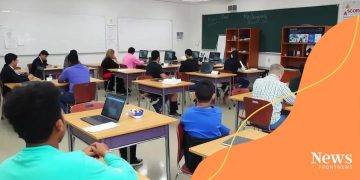Inclusive classrooms: understanding the benefits for all

Inclusive classrooms enhance student learning by fostering collaboration, improving academic performance, and supporting social-emotional development through tailored strategies that address diverse needs.
Inclusive classrooms are transforming education by ensuring that every student feels valued and supported. Have you ever wondered how inclusive classrooms create a better learning environment? In this article, we’ll delve into the benefits and strategies to make classrooms welcoming for all.
What defines an inclusive classroom?
Understanding what defines an inclusive classroom is essential for creating a nurturing learning environment. Inclusive classrooms foster a sense of belonging for all students, where differences are not only acknowledged but embraced.
Key Characteristics of Inclusive Classrooms
Inclusive classrooms exhibit several defining traits that support diverse learners. These characteristics set the stage for a successful educational experience.
- Diversity in Learning: Students with different learning styles and abilities are welcomed and accommodated.
- Collaboration: Teachers work alongside special educators to devise strategies that help every student succeed.
- Supportive Environment: Emotional and social support is prioritized, ensuring all students feel safe and valued.
- Flexible Curriculum: The curriculum is adaptable to meet the varying needs of students.
Furthermore, the classroom layout plays a significant role. An inclusive setting often features flexible seating arrangements that promote interaction among students. By encouraging teamwork and collaboration, these classrooms help build friendships and understanding across diverse groups.
Fostering Engagement and Participation
Another important aspect of inclusive classrooms is the emphasis on engagement. Teachers actively encourage participation from all students by implementing various instructional strategies that cater to different levels of ability.
For example, group work allows students to contribute in ways that highlight their strengths. Additionally, using technology can help bridge gaps in learning and provide tailored support that individual students may need.
Establishing a culture of respect is also vital. When students see their peers being treated with kindness and fairness, they are more likely to mirror that behavior. Promoting values of respect and empathy cultivates a positive learning atmosphere.
Community Involvement
Finally, the community plays a crucial role in defining an inclusive classroom. Involvement from families and community members enhances support for diverse learners. Schools that encourage family engagement create stronger connections between home and school, ultimately benefiting all students.
Overall, defining an inclusive classroom involves understanding its main characteristics. By fostering engagement, encouraging collaboration, and involving the community, educators can create an enriching atmosphere where every student thrives.
The benefits of inclusive classrooms for students
The benefits of inclusive classrooms for students are numerous and impactful. These classrooms offer a unique learning atmosphere where every student, regardless of their abilities, can thrive and succeed.
Enhanced Social Skills
Students in inclusive classrooms often develop better social skills. By interacting with classmates from various backgrounds, including those with disabilities, students learn to communicate effectively and build friendships.
- Empathy: Students learn to understand and appreciate differences.
- Collaboration: Group projects promote teamwork and cooperation.
- Conflict Resolution: Working with diverse peers helps them navigate social challenges.
Moreover, inclusive settings create a safe environment that encourages open dialogue. Students feel more comfortable expressing their thoughts and ideas, fostering a greater sense of community.
Improved Academic Performance
Another significant advantage is the potential for improved academic performance. In an inclusive classroom, teaching strategies are often tailored to suit various learning styles. This individualized attention helps all students grasp complex concepts.
Additionally, peer learning becomes a valuable resource. Students often learn from one another, as those who grasp a subject quickly can help their classmates understand it better. This collaborative learning atmosphere contributes to overall academic success.
Increased Confidence and Motivation
Students in inclusive classrooms also experience higher levels of confidence. When they see their contributions valued, it encourages them to participate more actively in their learning.
This boosted confidence can lead to greater motivation. Students who feel supported are likely to take on challenges and engage more deeply in their education, striving for excellence.
Preparation for Real-World Interactions
Inclusive classrooms prepare students for a diverse world. They learn to appreciate differences and understand that everyone has unique strengths and weaknesses.
Such experiences help cultivate skills that are beneficial beyond the classroom, setting students up for success in future social and professional interactions. Embracing diversity in the classroom not only enriches their educational journey but also shapes them into compassionate, well-rounded individuals.
Strategies for implementing inclusivity

Implementing inclusivity in the classroom requires thoughtful strategies that support all students. These approaches can create a nurturing environment where everyone can succeed, especially in an inclusive classroom.
Creating a Welcoming Environment
First, educators should focus on creating a welcoming atmosphere. This means having a classroom layout that promotes interaction and visibility. By arranging desks in a circle or small groups, teachers encourage collaboration.
- Display Diverse Materials: Use books, posters, and resources that reflect various cultures and abilities.
- Encourage Student Input: Allow students to share their ideas and preferences on classroom activities.
- Inclusive Language: Use language that promotes respect and understanding among classmates.
Students feel more comfortable and valued in an environment that respects diverse perspectives. Every student should know their voice matters, fostering a strong sense of community.
Tailoring Instructional Strategies
Next, tailoring instructional strategies to meet the needs of all learners is crucial. Teachers should use a variety of teaching methods to reach different learning styles. For instance, incorporating visual aids, hands-on activities, and group discussions can address diverse learning preferences.
Some practical approaches include differentiated instruction, where tasks are tailored based on student readiness. This enables students to work at their own pace and level of understanding. Additionally, flexible grouping allows students to collaborate with different peers, enhancing social skills.
Providing Support and Resources
Another effective strategy involves providing appropriate support and resources for students. This includes using assistive technology, which can greatly benefit students with disabilities. Tools like speech-to-text software or audio books ensure that all students can access the curriculum.
Alongside technology, support from special education staff can help identify specific student needs. Collaboration between general and special education teachers ensures that all students receive the assistance necessary for success in an inclusive classroom.
Engaging Families
Involving families in the educational process is another key strategy. When parents feel included, they are more likely to support their child’s learning journey. Schools can create workshops to educate families on how to aid inclusivity at home.
Regular communication between teachers and families fosters a productive partnership. This engagement helps track student progress and addresses any concerns collaboratively. By building these connections, schools can create a more inclusive community that supports all students.
Challenges educators face in inclusivity
Educators striving for inclusivity in the classroom often encounter various challenges. These hurdles can greatly impact the effectiveness of creating an inclusive classroom, but understanding them is the first step toward overcoming them.
Limited Resources
One significant challenge is the lack of resources. Many schools face funding cuts, which can limit access to materials and training required for inclusivity.
- Assistive Technologies: Schools may lack the necessary technology to support students with disabilities.
- Staff Training: Professional development opportunities to train teachers in inclusive practices may be insufficient.
- Adaptable Curriculum: Resources that cater to diverse learning needs might not be widely available.
Without adequate resources, teachers may struggle to provide the support that all students need to thrive.
Time Constraints
Time is another pressing issue for educators. With busy schedules, teachers often find it challenging to meet the individual needs of students.
Planning lessons that accommodate all learning styles can be time-consuming. Teachers may also have limited time to collaborate with special education staff and parents, slowing progress toward inclusivity.
Resistance to Change
Resistance to change can hinder the implementation of inclusive practices. Some educators may be hesitant to adopt new methods or strategies, preferring traditional teaching approaches.
This reluctance can stem from a lack of training or confidence in handling diverse classrooms. Building a culture of inclusivity may require significant effort to change mindsets among staff
Additionally, parents’ and community members’ attitudes toward inclusion can affect implementation. If families do not understand the benefits of inclusivity, they may resist changes in teaching approaches.
Classroom Management
Effective classroom management can be a significant challenge in inclusive settings. Managing a classroom with students of varying abilities requires flexible strategies that cater to each student’s needs.
Educators must balance the dynamics of group work while ensuring that all students remain engaged. When students have differing levels of understanding, it can lead to frustration and confusion for both teachers and students.
By acknowledging these challenges, educators can begin to seek solutions that will allow them to create inclusive and supportive learning environments for all.
Measuring the success of inclusive classrooms
Measuring the success of inclusive classrooms involves various methods to evaluate how well students thrive in these environments. Understanding the effectiveness of inclusion is crucial for educators and administrators.
Assessment of Academic Performance
One way to measure success is through academic performance assessments. Educators can track students’ progress using standardized testing, classroom assignments, and projects. These evaluations provide insight into how well students are grasping the material.
- Individual Growth: Compare student performance before and after implementing inclusive practices to gauge improvement.
- Class Average: Assess class averages in various subjects to evaluate the overall impact of inclusivity.
- Differentiated Assessments: Use varied assessment methods to fit different learning styles and needs.
By analyzing these metrics, teachers can identify areas where students excel and where further support may be required.
Feedback from Students and Parents
Gathering feedback from students and parents is another effective way to measure success. Surveys and interviews can reveal how students perceive their learning environment.
When students feel accepted and supported, their feedback improves engagement and satisfaction levels. Parents can provide valuable insights into changes they notice at home related to their child’s confidence and willingness to participate in school. Positive feedback from both groups can reinforce the effectiveness of inclusive practices.
Social and Emotional Development
Measuring the social and emotional development of students is equally important. Inclusive classrooms should foster empathy, collaboration, and mutual respect among students.
Observing student interactions can provide insights into their social skills. Evaluating how well they work with others, handle conflicts, and build friendships can indicate the success of inclusivity.
Behavioral Metrics
Behavioral metrics can also reflect the effectiveness of inclusive practices. A reduction in disciplinary actions or behavioral issues can demonstrate a positive shift in classroom dynamics.
Positive behavior reinforces a supportive environment. Keeping track of behavioral incidents helps educators understand whether the inclusion strategies are working and if students feel more comfortable in the classroom.
Overall, measuring the success of inclusive classrooms requires a comprehensive approach. By combining academic assessments, feedback from the community, social development metrics, and behavioral data, educators can create a clear picture of how inclusivity is impacting student learning and growth.
In conclusion, creating and measuring the success of inclusive classrooms is vital for the growth of all students. By implementing thoughtful strategies, educators can overcome challenges and foster a learning environment where every student feels valued. Success in inclusivity is not just about academic performance but also includes social, emotional, and behavioral development. Continuous assessment helps in refining these inclusive practices, ensuring that teachers can meet diverse needs effectively. Ultimately, an inclusive classroom prepares students for a diverse world, encouraging empathy and cooperation among future generations.
FAQ – Frequently Asked Questions about Inclusive Classrooms
What are the main benefits of an inclusive classroom?
Inclusive classrooms enhance social skills, improve academic performance, and boost student confidence while preparing them for real-world interactions.
How can educators measure the success of inclusivity in classrooms?
Success can be measured through academic performance assessments, feedback from students and parents, and observing social and emotional development.
What challenges do educators face when implementing inclusive practices?
Challenges include limited resources, time constraints, resistance to change, and effective classroom management.
How can parents get involved in promoting inclusivity?
Parents can participate by providing feedback, attending workshops, and collaborating with teachers to support their child’s learning experiences.





